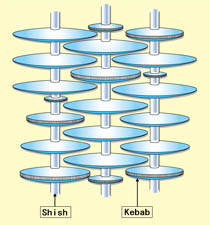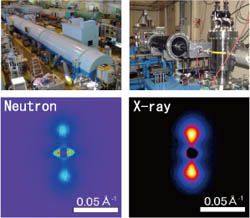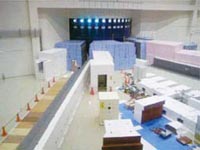Professor KANAYA, Toshiji, Assistant Professor MATSUBA, Go, Associate Professor NISHIDA, Koji “Polymer Crystallization under Flow” (Topics in May 2008, from “Macromolecules” 15 May 2007)
| Professor KANAYA, Toshiji; Assistant Professor MATSUBA, Go; Associate Professor NISHIDA, Koji Division of Multidisciplinary Chemistry, Laboratory of Polymer Materials Science “Polymer Crystallization under Flow” from “Macromolecules,” 15 May 2007 |
 Prof Kanaya T(left), Assist Prof Matsuba G(middle), Assoc Prof Nishida K(right) |
|
 Figure 1. Schematic illustration of shish-kebab. Shish is an extended chain crystal and Kebab is a folded-chain crystal. |
Shopping bags made of polyethylene could be fibers stronger in tensile modulus and strength than steel when the higher order structure is properly controlled. Creation of ultra-high modulus and ultra-high strength polymers is a dream of polymer scientists. In fact, such strong fiber has been realized in polyethylene; however this is not the case in all polymers. Therefore, many studies have been performed to elucidate the higher order structure of the strong fiber, and it is now believed that the “shish-kebab” (Figure 1) is the structural basis of the ultra-high modulus of the fiber. This name comes from Turkish baked meat on a spit: shish is an extended chain crystal and kebab is a folded-chain crystal. Once we know the formation mechanism of the “shish-kebab” we could produce ultra-high modulus fibers from any sorts of polymers. However, it is not clarified at the moment, in spite of the enormous efforts of polymer scientists. | |
| In our laboratory we have started to attack this longstanding subject in polymer science because we thought that recent development of advanced characterization techniques such as laser light scattering, synchrotron radiation (SR) X-ray scattering and neutron scattering shed light on new aspects of the shish-kebab formation. An example of small-angle SR X-ray and neutron scattering measurements performed on an elongated fiber of deuterated and protonated polyethylene blend is shown in Figure 2. The quantitative analysis of the data has elucidated that the “shish-kebab” was formed through a precursor in micrometer scale. In May 2008, we will have a new big pulse neutron source (J-PARC) in Tokai (Figure 3). We are expecting that the new intense neutron will elucidate the whole picture of the shish-kebab formation. | ||
 Figure 2. Small-angle neutron scattering machine (SANS-U at JRR-3 reactor in Tokai) and small-angle X-ray scattering machine (BL45XU at SPring-8 in Nishiharima) (upper). 2D scattering patterns of an elongated fiber of deuterated and protonated polyethylene blend (lower). |
 Figure 3. Neutron experimental hall at J-PARC under construction.
|
|
 Institute for Chemical Research, Kyoto University
Institute for Chemical Research, Kyoto University International Joint Usage Research Center
International Joint Usage Research Center